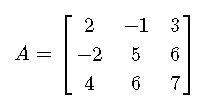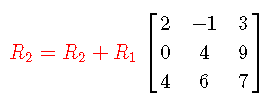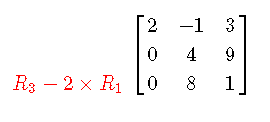Find Determinant Using the Row Reduction
Examples and questions with their solutions on how to find the determinant of a square matrix using the row echelon form are presented. The main idea is to row reduce the given matrix to triangular form then calculate its determinant. The determinant of the given matrix is calculated from the determinant of the triangular one taking into account the properties listed below.
Determinant Properties and Row Reduction
We reduce a given matrix in row echelon form (upper triangular or lower triangular) taking into account the following properties of determinants:
Property 1: If a linear combination of rows of a given square matrix is added to another row of the same square matrix, then the determinants of the matrix obtained is equal to the determinant of the original matrix.
Property 2: If two rows of a given matrix are interchanged, then the determinant of the matrix obtained is equal to the determinant of the original matrix multiplied by - 1.
Property 3: If a row of a given matrix is multiplied by a scalar k, then the determinant of the matrix obtained is equal to the determinant of the original matrix multiplied by k.
Examples on Finding the Determinant Using Row Reduction
Example 1
Combine rows and use the above properties to rewrite the 3 × 3 matrix given below in triangular form and calculate its determinant.

Solution to Example 1
Let D be the determinant of the given matrix.
step 1: add row(1) to row(2) - see property (1) above - the determinant does not change D

step 2: subtract 2 times row(1) from row(3) - see property (1) above - the determinant does not change D

step 3: subtract 2 times row(2) from row(3) - see property (1) above - the determinant does not change D
 Now that the matrix is in triangular form, the determinant of the given matrix is calculated as the product of the elements in the main diagonal (upper left to lower right).
Now that the matrix is in triangular form, the determinant of the given matrix is calculated as the product of the elements in the main diagonal (upper left to lower right).
Determinant of the triangular matrix = (2)(4)(-17) = - 136 = D = Det(A)
Example 2
\( \) \( \) \( \) \( \)
Combine rows and use the above properties to rewrite the 5 × 5 matrix given below in triangular form and calculate its determinant.
\[ A = \begin{bmatrix}
-1&0&-1&3&6\\
1&1&-1&0&4\\
1&-3&0&-2&2\\
-1&2&2&1&-3\\
0&-1&2&0&2
\end{bmatrix} \]
Solution to Example 2
Let D be the determinant of matrix A.
Step 1: we add rows to other rows as shown below and according to property (1) the determinant does not change D.
\[ \color{red}{\begin{matrix}
\\
R_2 + R_1 \\
R_3 + R_1\\
R_4 + R_2\\
\\
\end{matrix} }
\begin{bmatrix}
-1&0&-1&3&6\\
0&1&-2&3&10\\
0&-3&-1&1&8\\
0&3&1&1&1\\
0&-1&2&0&2
\end{bmatrix} \]
Step 2: we add multiples of rows to other rows as shown below and according to property (1) the determinant does not change D.
\[ \color{red}{\begin{matrix}
\\
\\
R_3 + 3 \times R_2\\
R_4- 3 \times R_2\\
R_5 + R_2
\end{matrix} }
\begin{bmatrix}
-1&0&-1&3&6\\
0&1&-2&3&10\\
0&0&-7&10&38\\
0&0&7&-8&-29\\
0&0&0&3&12
\end{bmatrix} \]
Step 3: we add a row to another row as shown below and according to property (1) the determinant does not change D.
\[ \color{red}{\begin{matrix}
\\
\\
\\
R_4+R_3\\
\\
\end{matrix} }
\begin{bmatrix}
-1&0&-1&3&6\\
0&1&-2&3&10\\
0&0&-7&10&38\\
0&0&0&2&9\\
0&0&0&3&12
\end{bmatrix} \]
Step 4: we add a multiple of a row to another row as shown below and according to property (1) the determinant does not change D.
\[ \color{red}{\begin{matrix}
\\
\\
\\
\\
R_5 - \dfrac{3}{2} R_4
\end{matrix} }
\begin{bmatrix}
-1&0&-1&3&6\\
0&1&-2&3&10\\
0&0&-7&10&38\\
0&0&0&2&9\\
0&0&0&0&-\dfrac{3}{2}
\end{bmatrix} \]
The matrix is now in triangular for and its determinant is given by the product of the entries in the main diagonal
Determinant of the triangular matrix = (-1)(1)(-7)(2)(-3/2) = - 21 = D = Det(A)
Note: Compare this method of calculating the determinant of a square matrix with the method of cofactors in determinant of a square matrix. Which method is more efficient?
Example 3
calculte the determinant of the matrix
\[ A = \begin{bmatrix}
-1&2&4&6\\
0&0&1&7\\
-1&2&4&14\\
0&2&4&6
\end{bmatrix} \]
Solution to Example 3
Let D be the determinant of the given matrix.
Step 1: subtract row (1) from row (3) and according to property (1) the determinant does not change.
\[ \color{red}{\begin{matrix}
\\
\\
R_3 - R_1\\
\\
\end{matrix} }
\begin{bmatrix}
-1&2&4&6\\
0&0&1&7\\
0&0&0&8\\
0&2&4&6
\end{bmatrix} \]
Step 2: interchange rows (3) and (4) and according to property (2) the sign of the determinant change sign to - D
\[ \color{red}{\begin{matrix}
\\
\\
\text{from } R_4\\
\text{from } R_3\\
\end{matrix} }
\begin{bmatrix}
-1&2&4&6\\
0&0&1&7\\
0&2&4&6\\
0&0&0&8
\end{bmatrix} \]
Step 3: interchange rows (2) and (3) and according to property (2) the sign of the determinant change sign to -(- D)
\[ \color{red}{\begin{matrix}
\\
\text{from } R_3\\
\text{from } R_2 \\
\\
\end{matrix} }
\begin{bmatrix}
-1&2&4&6\\
0&2&4&6\\
0&0&1&7\\
0&0&0&8
\end{bmatrix} \]
The matrix is now in triangular form and its determinant is given by the product of the entries in the main diagonal
Determinant of the triangular matrix = (-1)(2)(1)(8) = - 16 = -(- D) = D = Det(A)
Questions on Determinant and Row Reduction
Part 1
Use the method of row echelon form to calculate the determinant of the matrices.
\( A = \begin{bmatrix}
1&-1&-3&0&1\\
-1&0&0&1&5\\
1&-1&1&4&5\\
0&0&1&0&-1\\
1&0&1&2&2
\end{bmatrix} \)
Part 2
The determinant of matrix \( A = \begin{bmatrix}
a&b&c\\
d&e&f\\
g&h&k
\end{bmatrix} \) is equal to D.
Find the determiant, in terms of D, of the following matrices
a) \( \begin{bmatrix}
2a&2b&2c\\
d&e&f\\
-3g&-3h&-3k
\end{bmatrix} \) , b) \( \begin{bmatrix}
d&e&f\\
a&b&c\\
7g&7h&7k
\end{bmatrix} \)
Solutions to the Above Questions
Part 1
Let D be the determinant of the given matrix A.
step 1: Exchange row 4 and 5; according to property (2) the determinant change sign to: - D.
\[ \begin{bmatrix}
1&-1&-3&0&1\\
-1&0&0&1&5\\
1&-1&1&4&5\\
1&0&1&2&2 \\
0&0&1&0&-1
\end{bmatrix} \]
step 2: add multiples of rows to other rows; the determinant does not change: - D.
\[ \color{red}{\begin{matrix}
\\
R_2+R_1 \\
R_3-R_1 \\
R_4-R_1\\
\\
\end{matrix} }
\begin{bmatrix}
1&-1&-3&0&1\\
0&-1&-3&1&6\\
0&0&4&4&4\\
0&1&4&2&1\\
0&0&1&0&-1
\end{bmatrix} \]
step 3: add a multiple of a row to another row; the determinant does not change: - D.
\[ \color{red}{\begin{matrix}
\\
\\
\\
R_4+R_2\\
\\
\end{matrix} }
\begin{bmatrix}
1&-1&-3&0&1\\
0&-1&-3&1&6\\
0&0&4&4&4\\
0&0&1&3&7\\
0&0&1&0&-1
\end{bmatrix} \]
step 4: add multiples of rows to other rows; the determinant does not change: - D.
\[ \color{red}{\begin{matrix}
\\
\\
\\
R_4-(1/4)R_3\\
R_5 - (1/4)R_3
\end{matrix}}
\begin{bmatrix}
1&-1&-3&0&1\\
0&-1&-3&1&6\\
0&0&4&4&4\\
0&0&0&2&6\\
0&0&0&-1&-2
\end{bmatrix} \]
step 5: add a multiple of a row to another row; the determinant does not change: - D.
\[ \color{red} {\begin{matrix}
\\
\\
\\
\\
R5 + (1/2)R4
\end{matrix} }
\begin{bmatrix}
1&-1&-3&0&1\\
0&-1&-3&1&6\\
0&0&4&4&4\\
0&0&0&2&6\\
0&0&0&0&1
\end{bmatrix} \]
The matrix is now in triangular form and its determinant is given by the product of the entries in the main diagonal.
Determinant of the triangular matrix = (1)(-1)(4)(2)(1) = - 8 = - D
The determinant D of the given matrix is D = 8.
Part 2
a) row (1) is multiplied by 2 and row (3) by - 3, hence according to property (3) above, the determinant is 2 (-3) D = - 6 D.
b) rows (1) and (2) are interchanged and row (3) multiplied by 7, hence according to properties (2) and (3),
the determinant is (-1) 7 D = - 7 D.
More References and links
More References and links


 Now that the matrix is in triangular form, the determinant of the given matrix is calculated as the product of the elements in the main diagonal (upper left to lower right).
Now that the matrix is in triangular form, the determinant of the given matrix is calculated as the product of the elements in the main diagonal (upper left to lower right).
